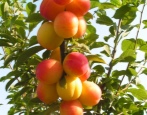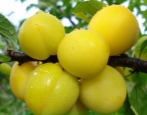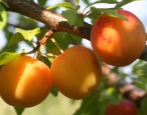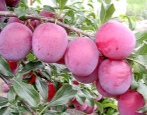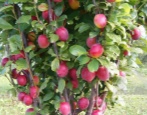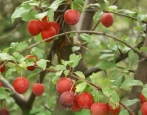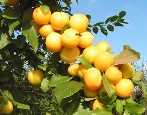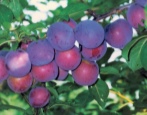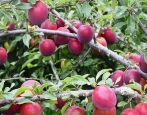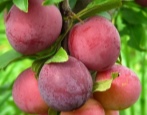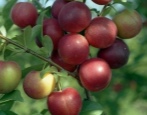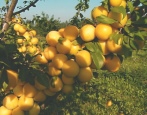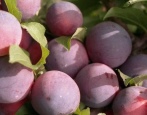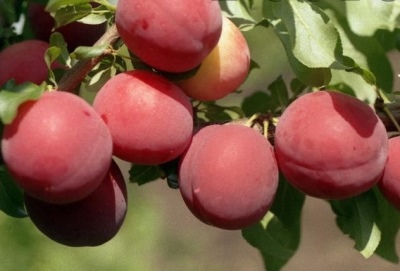
- Authors: G.V. Eremin, S.N. Zabrodina (Crimean experimental breeding station of the All-Russian Research Institute of Plant Industry named after N.I. Vavilov)
- Name synonyms: June rose, early comet
- Year of approval: 1999
- Growth type: medium-sized
- Ripening period: early
- Self-fertility: partially self-fertile
- Fruit size: medium or large
- Yield: high
- Appointment: for canning, for fresh consumption
- Marketability: good
Cherry plum variety July rose has existed for more than a dozen years. It has gained popularity among gardeners due to its high adaptability to growing conditions. As for the name, this variety is also known as the June rose and Kometa early.
Breeding history
He was born in the early 90s of the last century at the Crimean experimental station of the All-Russian Research Institute of Plant Industry named after V.I. N.I. Vavilov thanks to breeders G.V. Eremin and S.N. Zabrodina. Cherry plum was bred with the help of free pollination of the already existing at that time and quite popular variety Kuban comet. In the State Register since 1999. Unlike their "parent", July rose berries ripen early.
Description of the variety
By the type of growth, the tree is medium-sized with an even and gray stem of medium thickness. It has a modest size. The crown is characterized by medium density, flat-round. Shoots are medium in thickness, from 25 to 35 millimeters, located horizontally, branching weakly. The leaves are oval-shaped, very large. The upper side of the leaf is green in color, smooth and shiny to the touch.
Fruit characteristics
In shape, the berries are similar to an egg, the size ranges from medium to large - 41x37x37 mm. The fruits weigh about 32 grams, and you can see a slight coating of wax on them. The berries of the July rose are yellow in color, the integumentary color is scarlet with a pink tint. There is an average number of yellow spots under the skin. The abdominal suture is barely visible. The skin is elastic.
The pulp has a sunny color, grainy-fibrous, medium-dense, slightly juicy consistency. In addition, it does not darken immediately in the air. The aroma is weak. The seeds are not completely separated from the pulp and are medium in size. The fruits have medium acidity and the same sugar content.
The berries contain 9.80% of dry substances: sugars - 7.0%, acids - 2.3%, ascorbic acid - 6.67 mg / 100g. Sugar acid index 3.0.
Taste qualities
Fans of this cherry plum variety note that the berries are sweet, with a pleasant sourness. Professional tasters rate the taste of fresh fruits at 4.4 points. Collecting a bountiful harvest of the July rose, the housewives make tasty and useful preparations for the winter - jam, compote, juice with pulp.
Ripening and fruiting
Fruiting is regular and without leaps, occurs on small branches, the life of which lasts a couple of years. The July rose blooms in spring - early April. The flowers are small, each 18-20 mm in size. The emergence of berries is also not long in coming, their season falls on the end of June.
Yield
It can be noted that the yield of the July cherry plum is abundant and regular. Reaching the age of 8 years, the tree is capable of producing at least 10 kilograms of berries.
Growing regions
This variety is most widespread in the North Caucasus region (Crimea, Alania, Rostov region and other areas).
The need for pollinators
This type of cherry plum is referred to as partially self-fertile.This suggests that in order to increase the productivity and quality of berries, the tree must be pollinated. The pollinator can be another variety of cherry plum, which blooms with it at the same time (Nayden, Traveler).
Growing and care
The plant is planted in a place protected by some kind of barrier from cold winds, but the shadow of the barrier should not fall on the tree. The soil should be chosen loose, with a neutral reaction. The presence of nearby wetlands is strictly prohibited. The July rose variety is planted in early spring. According to the rules, you need to dig a hole, place a seedling there and tie it to a wooden peg. After that, the land is fertilized and watered abundantly.
This variety has a powerful immunity to diseases.
However, experts advise not to forget about preventive measures aimed at combating fungal infections.
In case of dry summers, this variety requires additional watering.
For cherry plum, the July rose is characterized by high winter hardiness, but the drought resistance of the variety is average, which is sometimes attributed to the shortcomings of the variety.
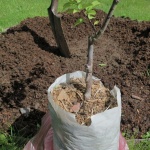
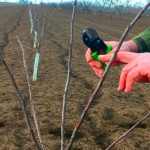

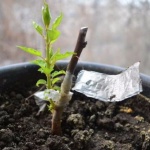
Review overview
Reviews of this variety of cherry plum can be described as generally positive. Gardeners note that the berry is tasty, juicy, gives a large harvest and does not cause unnecessary trouble when growing.

